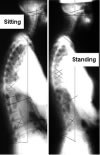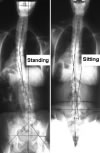|
...continued from page
3
mechanical stress pattern of the body and relieve
pain. However, that does not mean the patient’s condition
is improved. Very often treatment of those areas results in
an increased mechanical pathology with ot without precipitation
of symptoms elsewhere in the body not — thought to be
related.
This is also true of the patient in the films below who came
into the office two days past. He had been treated by 9 other
chiropractors, an osteopath, various types of massage therapies,
all including posterior-to-anterior pressure on the thoracic
spine. Pardon my abruptness but how is one to expect that
thoracic spine or any thoracic spine to improve by being flattened
further?
With the knowledge that many of those "hyperkyphosis"
are actually the thoracic spine pathologically falling forward
over a leverage point, P-to-A pressure on the thoracic spine
should be discarded as a therapy. This miscalculation, among
others even more significant but less obvious, have kept biostructural
therapies from being effective with every patient that presents
for treatment.
References
1. Breig, A.: Biomechanics of the Central Nervous System
1960, Almqvist, Stockholm
2. Breig, A.: Adverse Mechanical Tension in the Central
Nervous System 1978, Almqvist, Stockholm
3. Breig, A.: Skull Traction and Cervical Cord Injury
1989, Almqvist, Stockholm
4. Kabat, H.: Low Back and Leg Pain From a Herniated Cervical
Disc 1980, Green, St. Louis
5. Sachs, E.: Diagnosis and treatment of brain tumors
and care of the neurosurgical patient. 2 Ed. Mosby, St. Louis,
IL 1949.
6. Ward, L.: The Dynamics of Spinal Stress 1980, Long
Beach, CA.
7. Yochum T, Rowe L,: Essential of Skeletal Radiology
1986, Williams, Baltimore.
Three of these pictures have the extravertebral
area darkened for better viewing. The configurations are unaltered.
Now it’s your turn. These are a set of full spine standing
and sitting laterals and AP’s taken of a young lady within
four minutes. What is the direction of her main biomechanical
pathology?
Think in three dimensions. Is her main biomechanical pathology
that she is twisted anterior-left, posterior-left, anterior-right,
posterior-right? Would you adjust this woman’s thoracic
spine P-to-A? Is that lumbar scoliosis a biomechanical pathology
(subluxation complex) to be concerned about? Is it a compensation
that will quickly disappear when you start to correct the
main pathology? What about the thoracic scoliosis? Why does
her cervical lordosis disappear when she stands?
Her complaint was neck pain and headaches. She was scheduled
for TMJ surgery four weeks from her first visit to our office
because she could not open her mouth more than half the width
of her thumb.
What would you do if you only had standing laterals of the
area of pain, her cervical spine? Do you know how to handle
people with managed care?
These pictures are not very clear for faster loading of this
page. If you right click on the picture and click open in
another window, you can get a more clear view. Do it for each
picture pair and place them side by side. You can also print
them out and look at the hard copy which will have better
resolution.
Write up your analysis on a sheet of paper.
Fax it to me at the number above or mail it,
I will reply.

top
|







